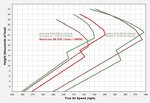wuzak
Captain
Hi guys, I know we touched on this in another thread, which would have been a better long term bet for using the Merlin XX series - the Hurricane or the Spitfire.
In one corner we have the Hurricane II, the aircraft which was actually built. It desparately needed the performance upgrade that came with the XX and its new 2 speed supercharger. But was it enough to keep the Hurricane competitive?
In the other corner is an aircraft that only existed as a prototype - the Spitfire III. This had numerous modifications to the Spitfire, including retracting tailwheel and fully covered undercarriage. The Spitfire III first flew in March 1940 (possibly with a Merlin X, the first 2 speed Merlin).
With so many changes required, the III was put on the backburner, whilst the interim V took centre stage. With the single speed 45 and mostly unchanged airframe, the V could go into production very quickly, whereas the III could possibly take a while.
One of the reasons that the III wasn't persued was the lack of engines, the XX being early in its production run. A year later and the 60-series Merlins were being developed, so any thought of putting a XX into the Spitfire was now gone.
Regarding engine availability, some 4900 Merlin Mk Xs were built between 1938 and 1942 (according to Lumsden). Woul dthe X have proved more useful in Hurricanes and Spitfires than in Whitleys and Wellingtons?
So how good coule the Spitfire III have been? Anyone have any performance data - tested or projected?
How does the III compare with the V and the Hurricane II?
And would it have held its own against the Fw 190s and Bf 109Fs?
In one corner we have the Hurricane II, the aircraft which was actually built. It desparately needed the performance upgrade that came with the XX and its new 2 speed supercharger. But was it enough to keep the Hurricane competitive?
In the other corner is an aircraft that only existed as a prototype - the Spitfire III. This had numerous modifications to the Spitfire, including retracting tailwheel and fully covered undercarriage. The Spitfire III first flew in March 1940 (possibly with a Merlin X, the first 2 speed Merlin).
With so many changes required, the III was put on the backburner, whilst the interim V took centre stage. With the single speed 45 and mostly unchanged airframe, the V could go into production very quickly, whereas the III could possibly take a while.
One of the reasons that the III wasn't persued was the lack of engines, the XX being early in its production run. A year later and the 60-series Merlins were being developed, so any thought of putting a XX into the Spitfire was now gone.
Regarding engine availability, some 4900 Merlin Mk Xs were built between 1938 and 1942 (according to Lumsden). Woul dthe X have proved more useful in Hurricanes and Spitfires than in Whitleys and Wellingtons?
So how good coule the Spitfire III have been? Anyone have any performance data - tested or projected?
How does the III compare with the V and the Hurricane II?
And would it have held its own against the Fw 190s and Bf 109Fs?


